Kalahari's Buffalo Blueprint: Habitat Preferences, Diets, and Evolutionary Edges
Kalahari’s Buffalo Blueprint explores how Africa’s desert-dwelling buffalo thrive where water is scarce and temperatures soar. These animals balance strength, stamina, and strategy to endure the dry, unpredictable heart of the Kalahari.
Habitat Preferences: Finding Water in a Harsh Landscape
The Kalahari isn’t a true desert—it’s a semi-arid expanse with seasonal waterholes and scattered vegetation. Buffalo seek areas where grasses recover quickly after rainfall. They migrate between pans, floodplains, and shaded thickets, adjusting routes with the shifting seasons. Their wide grazing range and strong spatial memory help them track reliable watering points even after months of drought.

Diet and Foraging Strategies
In wetter regions, buffalo feed mainly on lush grasses. In the Kalahari, they adapt to tougher fare. Coarse dry grasses, reeds, and even woody shrubs become staples during lean months. They graze during cooler hours—early morning and late evening—to conserve energy and reduce heat stress. By chewing cud efficiently, they extract maximum nutrients from low-quality vegetation, a vital adaptation for survival on the plains.
Evolutionary Edges and Physical Resilience
The Kalahari buffalo’s compact frame and darker hide aid heat regulation. Their thick hides resist dehydration and protect from sun exposure and biting insects. Larger nasal passages allow better air cooling during exertion, while powerful hooves handle shifting sand and cracked clay. Over generations, selective endurance has shaped them into some of Africa’s hardiest grazers—built for distance, defense, and desert life.

Survival Through Balance
In the end, what defines the Kalahari’s buffalo is adaptability. They blend instinct, social structure, and evolutionary design to overcome scarcity. Through synchronized herding and relentless resilience, these animals turn one of Africa’s toughest landscapes into a workable home.

